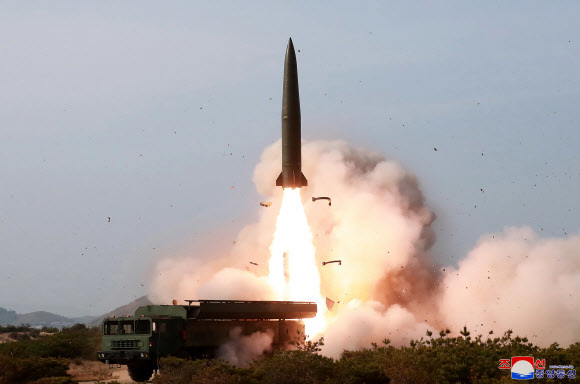Posted on : May.6,2019 14:51 KST
Modified on : May.6,2019 14:53 KST
 |
|
North Korea test launches a tactical missile thought to be the North Korean Iskander on May 4. (Yonhap News)
|
On May 4, North Korea carried out a low-level show of force, test firing several missiles, including multiple rocket launcher rounds and tactical guided missiles, into the East Sea. This appears to be an attempt to shake up the deadlock in its negotiations with the US that has dragged on since the breakdown of the Hanoi summit. This show of force is also notable considering that it took place immediately after US President Donald Trump emphasized cooperation on pressure on North Korea in a phone call with Russian President Vladimir Putin. It’s possible to see this show of force as expressing North Korea’s frustration with the US for maintaining pressure and sanctions and sticking to its strategy of arranging an all-in-one deal. But even if North Korea is dissatisfied with this situation, its actions are difficult to justify. The North is no doubt under a lot of pressure because of the sweeping sanctions and the deadlock in the negotiations, but escalating tensions through this kind of show of force doesn’t help advance the cause of peace on the Korean Peninsula.
The missiles that North Korea mobilized for this show of force had a low altitude and a short range. Though some believe that these were short-range ballistic missiles, there are signs that the North made a considerable effort, in its own way, to moderate this show of force. Fortunately, both South Korea and the US exercised restraint in regard to the North’s action. The Blue House remained calm, holding a meeting of the relevant ministers, who expressed their concern and called for a cessation of action that could raise tensions. The top diplomats in South Korea and the US also agreed that the two sides should act with prudence. Trump should also be praised for his temperate response, which shows his commitment to keeping North Korea-US relations from deteriorating. Tit for tat by North Korea and the US would only jack up tensions on the Korean Peninsula and throw a wrench in their negotiations.
But a restrained response doesn’t erase the tensions that have already been created. What’s more important is the next step. As long as North Korea and the US aren’t actively working to break through the deadlock in their negotiations, the tensions on the Korean Peninsula could rise even further. Furthermore, North Korea its desperate for internal solidarity because of its worst food crisis in the past 10 years. Relying solely on pressure and sanctions is likely to cause North Korea to lash out even more harshly at the outside world. A recent report by the UN’s World Food Programme shows that North Korea is expected to have a grain shortage of 1.36 million tons this year. That’s partly due to unusual temperatures, but it’s more of a manmade disaster resulting from sanctions on North Korea, which have led to an extreme shortage of fertilizer, fuel, and farming equipment. As members of the same Korean people, the South Korean government needs to roll up its sleeves and get to work in providing aid to the North. The international community shouldn’t just stand by and watch, either.
As it so happens, Stephen Biegun, the US State Department's special representative for North Korea, is planning to visit South Korea this week to attend the South Korea-US working group. During this meeting, the two countries need to reach an agreement about providing food aid and other kinds of humanitarian aid to the North. Such aid could serve as a link to resuming dialogue between South and North Korea, and between North Korea and the US. We hope that the meeting of the working group will lead to a forward-looking agreement that will go beyond sanctions and pressure and break the ice on North Korea-US dialogue. For its part, North Korea ought to quickly agree to the fourth inter-Korean summit already proposed by South Korean President Moon Jae-in instead of just waiting for a change of attitude from the US. If the two sides want to find a solution, they first need to meet.
Please direct comments or questions to [english@hani.co.kr]






